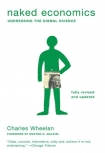Naked Economics by Wheelan, Charles (spanish books to read .txt) 📕

Read free book «Naked Economics by Wheelan, Charles (spanish books to read .txt) 📕» - read online or download for free at americanlibrarybooks.com
Read book online «Naked Economics by Wheelan, Charles (spanish books to read .txt) 📕». Author - Wheelan, Charles
Let’s jump from farm analogies to reality: So far, the United States owes China about a trillion dollars.
Normally these kinds of global imbalances have self-correcting mechanisms. The currency of a country with a large current account deficit will usually begin to depreciate. Assume that New Zealand is running a current account deficit. The rest of the world is steadily accumulating New Zealand dollars because they are selling more goods to New Zealand than they are buying from it; foreign firms will want to trade their accumulated New Zealand dollars for their home currency. On the foreign exchange market, the supply of New Zealand dollars for sale will exceed the demand for them, pushing the value of the New Zealand dollar down relative to the currencies of its trading partners. The falling New Zealand dollar helps to correct the trade imbalance by making New Zealand’s exports more competitive and imports more expensive. For example, if the New Zealand dollar depreciates relative to the yen, then Toyotas become more expensive in New Zealand while New Zealand’s farm products (kiwis?) look cheaper in Japan. Meanwhile, the same thing happens with other countries; New Zealand will begin to import less and export more, narrowing the current account deficit.
The current situation involving China and the United States is different. The two countries are arguably locked in an unhealthy symbiotic relationship that has the potential to come unglued at any time. China has created a very successful development strategy built upon “export-led growth,” meaning that the bulk of job growth and prosperity has been generated by firms making products for export. Many of those exports come to the United States.
China’s export-oriented development strategy depends on keeping the renminbi relatively cheap. To accomplish that, the Chinese government recycles accumulated dollars primarily into U.S. treasury bonds, which are loans to the U.S. federal government. Both parties get what they want (or need), at least in the short run. The Chinese government has used exports to generate jobs and growth. America has funded its dissavings with enormous loans from China. The situation really isn’t much different than Farmer China and Farmer America: The United States gets loans from China to buy its exports.
In the long run, the situation poses serious risks for both parties. The United States has become a large debtor nation. Debtors are always vulnerable to the whims and demands of their creditors. America has a borrowing habit; China feeds it. James Fallows has noted, “Without China’s billion dollars a day, the United States could not keep its economy stable or spare the dollar from collapse.”13 Worse, China could threaten to dump its huge hoard of dollar-denominated assets. That would be a ruinous thing to do. As Fallows points out, “Their years of national savings are held in the same dollars that would be ruined; in a panic, they’d get only a small share out before the value fell.” Still, that’s an awfully powerful weapon to give a nation with which we often disagree.
The Chinese have it worse. Suppose America’s debt burden grows beyond what U.S. taxpayers can (or are willing) to pay back. The U.S. government could default—simply refuse to honor its debts. That is highly unlikely, mostly because there is another irresponsible option that is more subtle: America can “inflate away” much of its debt to China (and other creditors) by printing money. If we recklessly print dollars, the currency will lose value—and so will our dollar-denominated debts. If inflation climbs to 20 percent, then the real value of what we have to pay back will fall by 20 percent. If inflation is 50 percent, then half of our debt to China effectively goes away. Is this a likely outcome? No. But if someone owed me a trillion dollars and also had the authority to print those dollars, I would spend a lot of time worrying about inflation.
This dysfunctional economic relationship will end. The crucial questions are when, why, and how. James Fallows has summarized where we stand now: “In effect, every person in the (rich) United States has over the past 10 years or so borrowed about $4,000 from someone in the (poor) People’s Republic of China. Like so many imbalances in economics, this one can’t go on indefinitely, and therefore won’t. But the way it ends—suddenly versus gradually, for predictable reasons versus during a panic—will make an enormous difference to the U.S. and Chinese economies over the next few years, to say nothing of bystanders in Europe and elsewhere.”14
Given the stakes involved, are any adults supervising all of this? Yes, but they are getting long in the tooth. In the waning days of World War II, representatives of the Allied nations gathered at the Mt. Washington Hotel in Bretton Woods, New Hampshire. (It’s a delightful place in both summer and winter, if you are looking for a New England getaway.) Their mission was to create a stable financial infrastructure for the postwar world. They created two international institutions, or “the two sisters.”
The institution at the center of the global fight against poverty is the Washington-based World Bank. (The first $250 million loan was to France in 1947 for postwar reconstruction.) The World Bank, which is owned by its 183 member countries, raises capital from its members and by borrowing in the capital markets. Those funds are loaned to developing nations for projects likely to promote economic development. The World Bank is at the center





Comments (0)